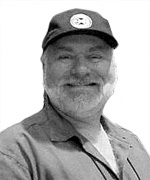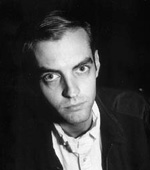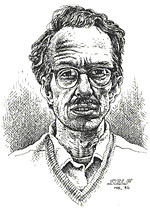>> Top Nine: Yusuf's Choice
>> Alphabetti Fumetti: S is for Shooter
More...

 C is for Claremont, Christopher
C is for Claremont, Christopher
b. 1950; London, England
1976: UNCANNY X-MEN
What's the point of scripting the same comic book series for an unbroken run of sixteen years? That's what Chris Claremont did with UNCANNY X-MEN between 1976 and 1991, and he has very little to show for it.
Of course, he helped develop a third-rate superhero team into one of the biggest intellectual properties in the spandex market, and Marvel has reaped the benefits, but Claremont himself has been given little artistic reward beyond the reverence of a dwindling fan-base. Perhaps he did it out of a sense of devotion to the characters. Or perhaps he did it because he had bills to pay. Either way, he has committed a sizeable chunk of his working life to these fictional characters, and his current position in the pecking order demonstrates how extended tenure will never be a substitute for outright ownership.
In the days when readers were deliriously happy and the sales continued to climb, Claremont might have kidded himself he was indispensable, but that illusion was shattered when editorial differences meant he had to quit in 1991. Quite frankly, he probably should've followed his true calling and written romantic novels instead.
Because romance, in a nutshell, is what Claremont is all about. He's the Barbara Cartland of comic books. The evidence is there in the strong female characters, or the way that fight scenes are punctuated by long-winded interior monologues, or the sharp arrows of unrequited love that ricochet from one character to another. His success boils down to a simple process of adding concentrated doses of high melodrama to the mutant gene pool. The largely male readership is blissfully unawares of it, but the triumphs and tragedies that have kept them so enamoured of the X-Men owe more Mills & Boon than they do to science fiction.
Claremont's work with John Byrne on UNCANNY X-MEN is still fondly regarded, and stories like the 'Dark Phoenix Saga' and 'Days of Future Past' represent the high watermark in serial superhero storytelling. The series also gave him the chance to work with several other industry greats, including Paul Smith, John Romita Jr and Alan Davis.
Claremont had strong editorial support from the likes of Louise Simonson and Jim Shooter during much of his tenure as he worked to carefully and credibly expand the mutant universe with a range of limited series, graphic novels and crossovers. Alas, caution was thrown to the winds as the popularity of the X-Men grew, and the line was expanded from one ongoing title to two (NEW MUTANTS) then three (X-FACTOR), four (EXCALIBUR), five (WOLVERINE), then six (X-MEN), with this last leading to Claremont's departure as the franchise became too big for him to steer.
After UNCANNY X-MEN, Claremont spent a few years penning novels, scripting SOVEREIGN SEVEN for DC, WILDCATS for Image and ALIENS VS PREDATOR for Dark Horse before returning to Marvel for a brief spell on FANTASTIC FOUR. In 2000, nearly ten years after he left the X-MEN, he was invited back to coincide with the release of the movie adaptation.
After all this time away, however, the thrill had long since gone; Claremont is a writer on autopilot, with very little in the way of inspiration or excitement left in his stories. One suspects that he is sticking around out of habit, dutifully cleaning up the mess left behind by a revolving door of freelancers and chancers. If that's the case, someone should tell Claremont to just throw in the towel and walk away.
 C is for Clowes, Daniel
C is for Clowes, Daniel
b. 1961; Chicago, Illinois
1989: EIGHTBALL
Clowes is best known for GHOST WORLD, the story of two teenage girls and the disintegration of their friendship, but his reputation continues to grow with other graphic novels like DAVID BORING and ICE HAVEN. Each of these stories originally appeared in his personal anthology title EIGHTBALL, which has a bit of a cult following amongst underground hipsters (you know who you are). His work is characterised by a fascination with the ugly and the mundane, the weird and weary characters who inhabit the fringes of Middle America.
It's not just a case of pointing and laughing, however. It's more like an ongoing work of social documentary. Through the process of observing, drawing, and bringing these people to life, Clowes makes them more interesting, and perhaps even beautiful. The driving force behind it all is a simmering resentment at our media-saturated world, the empty promises of advertising and television that has left generations of teenagers so bitter and apathetic.
Clowes has a remarkable ear for dialogue; the sparky conversations between Enid Coleslaw and Rebecca Doppelmeyer in GHOST WORLD are filled with biting sarcasm, post-modern irony, and casual swearing, and he demonstrates an apparently remarkable capacity to understand the minds of disaffected teenage girls. Where does it really come from? And is it any coincidence that 'Enid Coleslaw' is an anagram for 'Daniel Clowes'?
In 2001, GHOST WORLD became a film by Terry Zwigoff, but the original story of two friends growing up and going their separate ways was elbowed aside to accommodate a plot about Enid becoming romantically entangled with a geeky middle-aged record collector. This character, played by Steve Buscemi, was clearly an autobiographical analogue of Clowes, Zwigoff, and every other socially maladjusted nerd they'd ever met. From there, it wasn't a difficult leap of the imagination to see the queasy subtext of a middle-aged author who had just slept with his teenaged muse.
But all this is going off at the tangent. The art and ambition of Daniel Clowes continues to grow in leaps and bounds, and he belongs to a select group of alternative comics creators who have been lovingly embraced by the literary mainstream. Clowes is proof that the world might be filled with hideous freaks and geeks, but we're all pretty on the inside.
 C is for Crumb, Robert
C is for Crumb, Robert
b. 1943; Philadelphia, Pennsylvania
1967: ZAP COMIX; 1968: CHEAP THRILLS
The great granddaddy of alternative comics, Robert Crumb has grown from enfant terrible of the counter-culture to darling of the art establishment. Neither is a label that he is comfortable with, but as long as there's an audience for his work he will keep on drawing. Besides, it doesn't seem like he has a choice in the matter; for Crumb, drawing is an outlet for the steam that builds up in his pressure cooker of a brain. Images tumble out in a stream of consciousness, his pencil giving them form in a frantic flurry of cross-hatching and scratching.
The essential quality of his work is the way he uses the formal styles of early 20th century comic books and cartoons to show adult and taboo behaviours like sex and drugs and rock and roll. In the 60s, where the general opinion was that comics were just for kids, this was an outrageous and shocking thing to do, but Crumb's work was so alive with energy, humour and drug-induced psychedelia that it would have been impossible to keep him of print. Today, it's not a stretch to say that he was instrumental in changing the public perception of the medium, and his influence continues in the work of Chris Ware, Joe Sacco, and Daniel Clowes.
Crumb's depiction of women and African Americans remains problematic, as is the obsession with toilet humour and bodily functions. This is a direct consequence of producing work without self-censorship, and it should be noted that the attitudes he holds, acknowledged or otherwise, are the product of the society he grew up in. To some extent Crumb does take personal responsibility for his more controversial images, but he is also a mirror held up to the world around him. His art is a complicated blend of free expression, sexual peccadilloes and hard satire.
In addition to a vast body of published work, Crumb was introduced to a new audience in 1994 in a documentary also directed by Terry Zwigoff. Featuring Crumb and his surrounding kin, this film was a tender portrait of a talented family, and is required viewing for anyone interested in the history of comics. Naturally, Crumb didn't like it one bit.
For more on Robert Crumb, read Ninth Art's Thumbnail profile.

This article is Ideological Freeware. The author grants permission for its reproduction and redistribution by private individuals on condition that the author and source of the article are clearly shown, no charge is made, and the whole article is reproduced intact, including this notice.


